Timing & trends
From the iconic seventies rock band Jefferson Starship …
“If only you believed in miracles …
… like I believe …
… we’d get by.”
The US stock market is currently singing this song.
Indeed, we work our way backwards in today’s Money Monitor, starting with the markets, rather than the macro-data, by observing the chart on display below in which we plot the US S+P 500 stock index.
We focus on today’s upside breakout attempt, an event we anticipated as per yesterday’s Weldon LIVE. The US stock market is banking on a miracle …
… another monetary miracle, to be delivered by the Fed, via QEIII.
Evidence the daily chart on display below revealing that the benchmark US stock index (futures contract) is making a run at key overhead resistance defined by the July 5th intraday high of 1375.00 … in synch with support generated by a increasingly bullish moving average dynamic, and in line with the completed downside Fibonacci retracement.

Reviewing the chart of the S+P 500 exhibited at the bottom of the previous page, we spotlight the fact that the July 5th high of 1375 was established within the context of a key outside-downside reversal day.
Indeed, we observe that, currently, the S+P 500 is well below today’s intraday high, which did in fact ‘breach’ the July 5th high.
Food for thought …
… particularly when we can dissect the deluge of macro-economic data emanating from the US in the last week, and clearly conclude that DEFLATION is becoming increasingly dominant, as the primary macro-force.
Hence, it becomes an easy conclusion … the markets are pinning their hopes squarely on the shoulders of Ben Boom-Boom Bernanke.
The US stock market is riding on the wings of hope …
… and the rally could fly, for a while.
But at the end of the day … the US stock market is DEPENDENT on yet another monetary miracle from the Federal Reserve.
….read the entire 12 page report covering a breath of fascinating issues HERE.
Weldon’s research publications extends an invitation to sign up for a FREE TRIAL for thirty days.
Be sure to listen to Greg’s latest on Money Talks with Michael Campbell tomorrow at 9am PST. You can listen live or in podcast at CKNW.com
Weldon Financial produces independent research for the sophisticated investor and/or trader and offers investment management solutions that capitalize on global market trends. Greg Weldon is the founder and sole producer of all the research and operates his money management services as a registered Commodity Trading Advisor.
Weldon’s Money Monitor offers a very independent, objective view of the global markets by applying a top down market analysis and a bottom up technical analysis. Greg also publishes The Metal Monitor and The ETF Playbook offering specific focus on the precious metals markets (prices of Gold, Silver, etc.) and the world of Exchange Traded Funds, respectively. He has a creative and captivating writing style and his loyal readers have claimed that the ‘research pays for itself over time’.
The Global Macro-Discretionary Program manages money for individuals, joint, trust, corporate and partnership accounts. Mr. Weldon approaches his investment selections from a top-down macro-perspective and then applies his quantitative discipline from the bottom-up to execute his methodology, seeking to produce an absolute return while sharply focusing on risk management. This program invests in a diverse range of futures contracts across the commodity, currency, global stock index, and global fixed-income sectors. Weldon’s Commodity Long-Short Program takes a more quantitative approach, using our proprietary Momentum Trading Indicators, and invests strictly in the strongest ‘bullish’ and ‘bearish’ commodities.
….read the entire 12 page report covering a breath of fascinating issues HERE
Weldon’s research publications are explained in more detail in the Research section above including an invitation to sign up for a FREE TRIAL for thirty days.
One of Michael Campbell’s favorite analysts, Greg Weldon, is Michaels Guest Tomorrow on Money Talks.
From the iconic seventies rock band Jefferson Starship …
“If only you believed in miracles …
… like I believe …
… we’d get by.”
The US stock market is currently singing this song.
Indeed, we work our way backwards in today’s Money Monitor, starting with the markets, rather than the macro-data, by observing the chart on display below in which we plot the US S+P 500 stock index.
We focus on today’s upside breakout attempt, an event we anticipated as per yesterday’s Weldon LIVE. The US stock market is banking on a miracle …
… another monetary miracle, to be delivered by the Fed, via QEIII.
Evidence the daily chart on display below revealing that the benchmark US stock index (futures contract) is making a run at key overhead resistance defined by the July 5th intraday high of 1375.00 … in synch with support generated by a increasingly bullish moving average dynamic, and in line with the completed downside Fibonacci retracement.

Reviewing the chart of the S+P 500 exhibited at the bottom of the previous page, we spotlight the fact that the July 5th high of 1375 was established within the context of a key outside-downside reversal day.
Indeed, we observe that, currently, the S+P 500 is well below today’s intraday high, which did in fact ‘breach’ the July 5th high.
Food for thought …
… particularly when we can dissect the deluge of macro-economic data emanating from the US in the last week, and clearly conclude that DEFLATION is becoming increasingly dominant, as the primary macro-force.
Hence, it becomes an easy conclusion … the markets are pinning their hopes squarely on the shoulders of Ben Boom-Boom Bernanke.
The US stock market is riding on the wings of hope …
… and the rally could fly, for a while.
But at the end of the day … the US stock market is DEPENDENT on yet another monetary miracle from the Federal Reserve.
Be sure to listen to Greg’s latest on Money Talks with Michael Campbell tomorrow at 9am PST. You can listen live at CKNW.com
Weldon’s research publications extends an invitation to sign up for a FREE TRIAL for thirty days.
Weldon Financial produces independent research for the sophisticated investor and/or trader and offers investment management solutions that capitalize on global market trends. Greg Weldon is the founder and sole producer of all the research and operates his money management services as a registered Commodity Trading Advisor.
Weldon’s Money Monitor offers a very independent, objective view of the global markets by applying a top down market analysis and a bottom up technical analysis. Greg also publishes The Metal Monitor and The ETF Playbook offering specific focus on the precious metals markets (prices of Gold, Silver, etc.) and the world of Exchange Traded Funds, respectively. He has a creative and captivating writing style and his loyal readers have claimed that the ‘research pays for itself over time’.
The Global Macro-Discretionary Program manages money for individuals, joint, trust, corporate and partnership accounts. Mr. Weldon approaches his investment selections from a top-down macro-perspective and then applies his quantitative discipline from the bottom-up to execute his methodology, seeking to produce an absolute return while sharply focusing on risk management. This program invests in a diverse range of futures contracts across the commodity, currency, global stock index, and global fixed-income sectors. Weldon’s Commodity Long-Short Program takes a more quantitative approach, using our proprietary Momentum Trading Indicators, and invests strictly in the strongest ‘bullish’ and ‘bearish’ commodities.
Weldon’s research publications are explained in more detail in the Research section above including an invitation to sign up for a FREE TRIAL for thirty days.
Bernanke spoke before congress in the face of a Global Slowdown that includes a European Economic Smashup, a slumping USA and a China contracting as its former powerhouse customers have no money left to buy its production. Can Bernanke save us all?
Well if you listen to wise men like Jim Rogers he is sure going to try: “Mr. Bernanke is going to print more money…I wouldn’t pay much attention to the man…He only knows one thing – and that’s what he’s going to do…”
So what have we learned from Bernanke’s testimony:
1. Bernanke bluntly said in response to questions about the state of the economy that the US was “just “muddling through” while Europe was “already in recession.”
2. His prepared testimony went further, noting that GDP grew at a slower rate in the first quarter than in the second half of 2011 … and that the second quarter looks even worse. He also pointed out that payroll growth has plunged by 63 percent … that household confidence in future income remains low … and that business spending is waning.
3. Bernanke said the Fed could consider another round of quantitative easing, or QE3. Consider the effect that is likely to have given the previous attempts at easing (from Mike Larsen):
QE1 came at a time when the lending rates were very high and the credit markets were in complete disarray. It was a brand new policy nobody expected, and it had a huge impact in terms of bringing down spreads, rates, and risk levels.
But QE2 was less effective in terms of impact because market dysfunction was already largely fixed and because the underlying economy was weakening. Moreover, other similar programs from the European Central Bank’s LTRO1 and LTRO2 to Operation Twist 1 and 2, have had even less of an impact than QE2!
Just consider: A Credit Suisse note from a few days ago chronicled the findings of several studies on the impact of QE on 10-year Treasury Note yields. Several researchers estimated QE1 lowered yields by around 90 basis points to 100 basis points. But they also concluded that QE2 moved rates by as little as 13 basis points!
That was the supposed impact on the financial markets. The impact of several hundred billion dollars worth of QE on the real economy — meaning GDP — was as paltry as 40 basis points. That’s the difference between 0 percent growth and 0.4 percent growth, a drop in the bucket!
Yet somehow we’re supposed to believe that QE3 — the THIRD iteration of a policy that’s having less and less impact on financial markets, not to mention a near-zero impact on the real economy — will somehow be different?
Seems best to bet that we are being lead by an Ineptocracy which is “A system of government where the least capable to lead are elected by the least capable of producing, and where the members of society least likely to sustain themselves or succeed, are rewarded with goods and services paid for by the confiscated wealth of a diminishing number of producers”.
In other words, bet against the leaders of the US Government & Fed. How to do that? I think Jim Rogers say’s it best. He is clearly betting against the Ineptocracy when he states: “He remains totally committed to commodities over the long term as the global economy continues to be drowned in mountains of the bankers’ paper currencies, these hard assets must soar in price – as all that paper collapses in value.
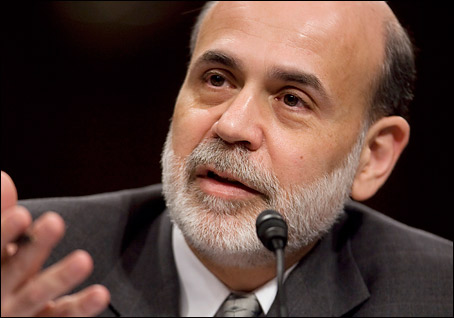
The first chart below shows the strong US dollar. The US dollar is the mirror twin of the euro. As a rule, a strong dollar works against gold. The stronger the dollar, the fewer dollars it requires to buy an ounce of gold; and the opposite is true, the weaker the euro, the more euros it takes to buy an ounce of gold. This is the reason my pen-pal, Dennis Gartman, buys his gold in euro terms.
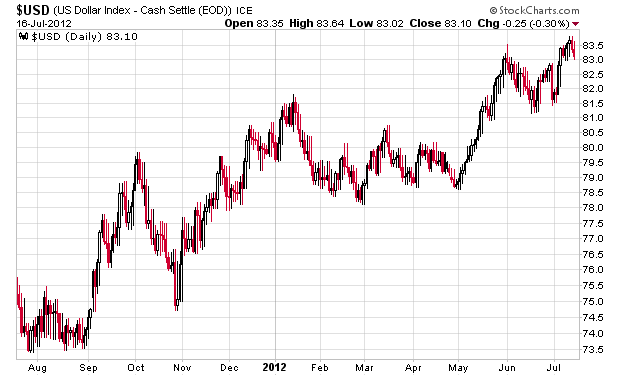
Below we see gold, and what is so interesting is that gold is holding above support at 1535 in the face of the strong dollar. This is obviously good action in terms of gold.
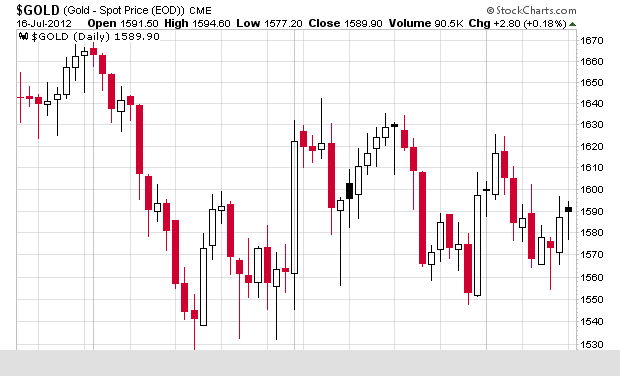
Just for the hell of it, I’m showing a daily chart of the euro. I think it’s over-priced at 1.22, and I think it’s going to par against the US dollar. I saw enough of Europe during WWII, and with the euro at 1.23, I’m staying in La Jolla where I can still get a meal for less than six bucks. The euro came out at 87 cents, which is what I think it’s really worth.
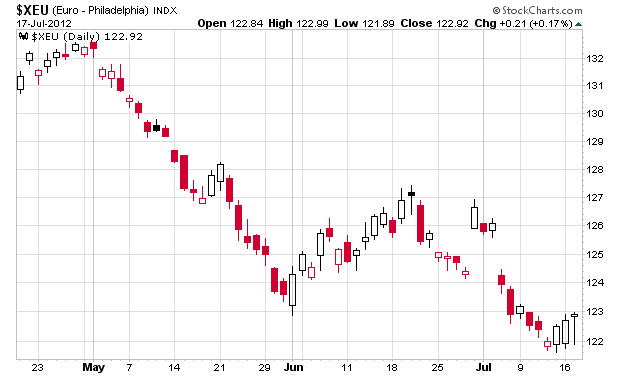
Ed Note: Richard Russell of Dow Theory Letters is bearish the US Stock Market based on the Dow Theory. His advice to investors right now it that: “This is the time to cut back on needless expenses — get rid of all the debt you can, and prepare for tough times”.
Russell began publishing Dow Theory Letters in 1958, and he has been writing the Letters ever since (never once having skipped a Letter). Dow Theory Letters is the oldest service continuously written by one person in the business. One of the favorite features of the Letter is Russell’s daily Primary Trend Index (PTI), which is a proprietary index which has been included in the Letters since 1971. The PTI has been an amazingly accurate and useful guide to the trend of the market, and it often actually differs with Russell’s opinions. But Russell always defers to his PTI. Says Russell, “The PTI is a lot smarter than I am. It’s a great ego-deflator, as far as I’m concerned, and I’ve learned never to fight it.”
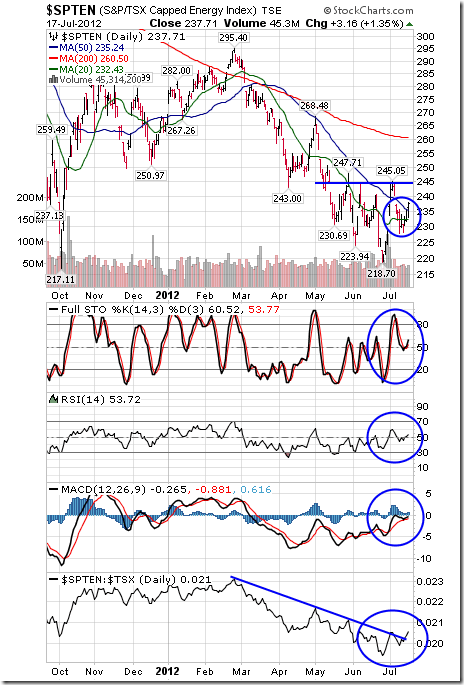
Ed Note: Josef Schachter has been suggesting since really early this year that oil was going down and that the markets in general are to take a hit. And oil will bottom some time in October.
He also suggests you buy the oil stocks, but unlike Vialoux wants to buy them 2 months later in October.
















